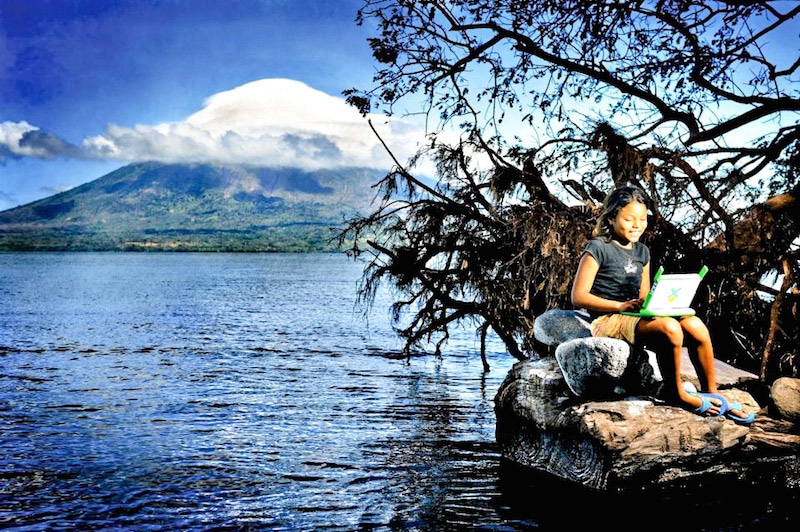Program offers computers with educational applications to children at 104 schools in low-income neighborhoods.
By Letzira Sevilla Bola̱os for Infosurhoy.com Р30/07/2013
Since 2009, 30,000 students from 104 schools in low-income neighborhoods in Nicaragua have received free XO computers through the One Laptop per Child program, offered through the Zamora Terán Foundation. (Elmer MartÃnez/AFP)
MANAGUA, Nicaragua – At least 30,000 students from low-income neighborhoods in Nicaragua now attend school with more than just pencils, notebooks and dreams in their backpacks.
They also have computers.
Since its creation in 2009, the One Laptop per Child program, which is being carried out by theZamora Terán Foundation, has provided XO laptops to students and 900 teachers at 104 schools in low-income neighborhoods in Nicaragua.
The XO is a laptop designed specifically for learning, featuring all of the benefits of a conventional computer. It offers 52 educational activities, Internet connectivity and an internal camera, according to Félix Garrido, the director of education and operations at the Zamora Terán Foundation.
The goal is to transform education in Nicaragua, where only 56% of students finish grade school, according to the United Nations Children’s Fund (UNICEF).
Another goal is to expand public access to the Internet, given only 15% of the population of six million are connected, according to Garrido.
Nicaragua is ranked 125th among 144 countries in the capacity to utilize information technology and communications to improve the economy and the population’s well-being, according to the Global Information Technology Report 2013.
The project has helped keep children in the classroom. In 2012, the retention rate was 97.32%, according to a Zamora Terán Foundation study that was supported by the Ministry of Education. Prior to the program’s implementation, the rate was about 85%.
Julio José Ramos Mendieta, 8, calls himself a computer genius. The third-grade student at San Francisco de AsÃs School in Diriamba, 45 kilometers south of Managua, received an XO three years ago. It was his family’s first computer.
“I type using all of my fingers. It was hard at first, but not anymore. I practice every day,†he said. “With this computer, I can play games, read stories and do my homework. I’m also teaching my cousin, who is 5 years old. When we grow up, I want us to be able to work in an office and have computers.â€
The laptop has changed the lives of all of his family members. Mendieta’s mother Bertha, 38, who has three other children, began studying and found that information in the computer’s hard drive helped her with her work.
Increasing enrollment
The San Francisco de AsÃs School has participated in the Zamora Terán Foundation’s program since 2010. Today, 85% of the school’s 550 students have a computer, said Martha Patricia Hernández, the school’s director.
“Enrollment is up 15% since we started providing the computers because the children get excited about receiving a device like this,†Hernández said.â€[Getting a computer would be almost impossible outside the program because of how much the equipment costs in Nicaragua. The cheapest units are about US$400, which is unaffordable for most of the population.â€
In Nicaragua, the minimum monthly wage in the agricultural sector is $2,421 Nicaraguan córdobas (US$95), while in construction, which offers higher salaries, it is $5,470 córdobas (US$216).
The One Laptop per Child program has been implemented in 25 countries. In Nicaragua, it has been introduced in the cities of Managua, León and Masaya. The program’s growth has been made possible through donations of more than US$6 million by 60 companies, NGOs and individuals, Garrido said.
Teachers become more tech savvy
The teachers and directors also receive an XO, allowing for more modern educational practices in the classroom because teachers can conduct research, stay updated and become more innovative, Hernández said. One of the programs is a virtual library with content related to each school subject.
“The teachers have to document their lesson plans with the XO,†Hernández said. “It’s a major challenge because some of us, due to our age and experience, struggle to use the technology.â€
The XO facilitates comprehension and language skills among first-grade students using a program called Hablar con Sara (Talk to Sara). The application alerts students if the word they’ve written is wrong, simplifying the reading process, Hernández said.
Project scope and goals
Each school has a Wi-Fi connection that allows students to complete their tasks. The system is installed at no cost to the school, through agreements with Internet providers.
Teachers also work with students to bolster computer knowledge.
While Garrido said officials are pleased with the results, he acknowledged that the job has just started, as officials want to give all of the country’s 600,000 grade school students an XO.









